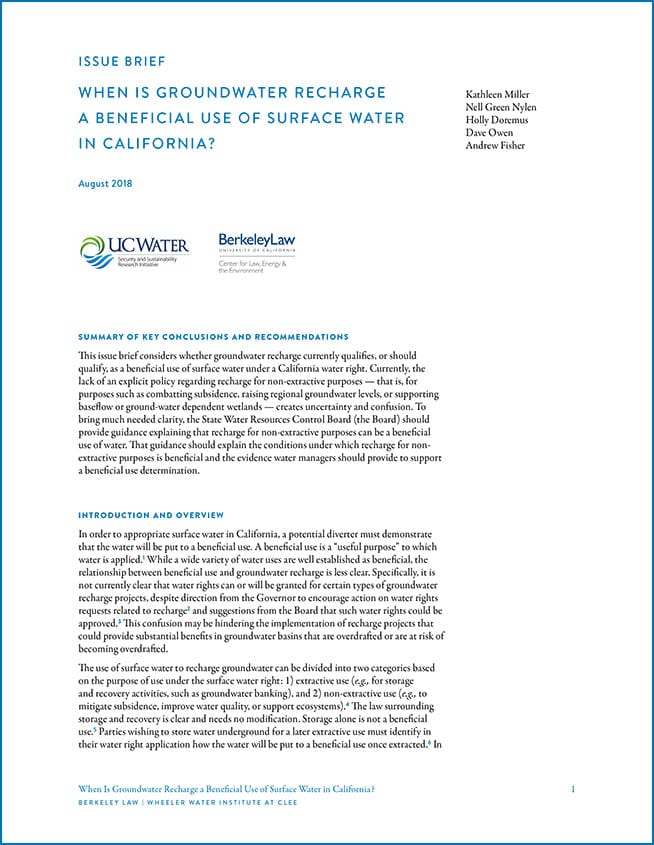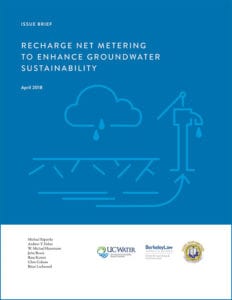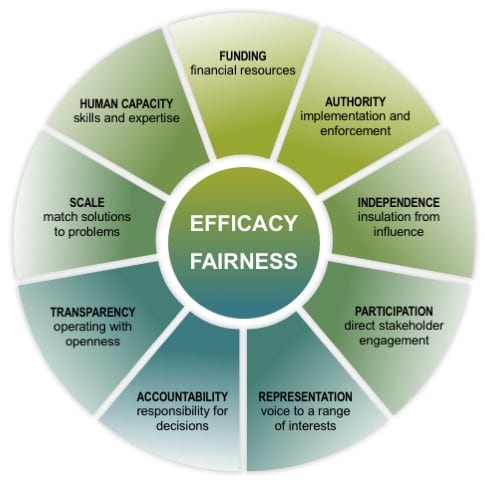California has historically overdrafted groundwater, especially in its agricultural basins, but with the passage of the Sustainable Groundwater Management Act (SGMA) in 2014, the state committed to local, sustainable management of groundwater resources. This ambitious goal is critical to California’s water security, but major questions remain about how to interpret and effectively implement this legislation.
Our policy reports seek to guide local groundwater sustainability agencies (GSAs), state agencies, and others with a stake in SGMA implementation.
October 2023
Recharge net metering (ReNeM) is a novel, cost-effective management strategy to incentivize groundwater recharge
Groundwater basins are mismanaged throughout California and the world, with dire economic, social, and environmental consequences. Managed aquifer recharge is emerging as an important method for bringing groundwater budgets into balance. However, although the best sites for recharge are often located on private property, property owners typically are not incentivized to invest in groundwater projects for the benefit of the basin. To address this gap, our team is supporting the development of recharge net metering (ReNeM), a new incentive structure that compensates private entities for operating groundwater recharge projects on their land.
CLEE led a team of co-authors from UC Berkeley and UC Santa Cruz to publish an economic analysis of ReNeM in Nature Water, titled “Recharge net metering (ReNeM) is a novel, cost-effective management strategy to incentivize groundwater recharge.” The article showcases ReNeM’s affordability and cooperative promise; it provides water managers with a method for understanding ReNeM’s financial implications; and it enables expansion of this new approach to groundwater management elsewhere.
See our related article in the Nov/Dec 2023 ARE Update: The Cost-Effectiveness of Using Rebates to Incentivize Groundwater Recharge
April 2021
The Institutional Dimensions of Groundwater Recharge: A Special Collection
Groundwater pumping exceeds naturally occurring recharge in many regions of the world. The resulting impacts to groundwater systems adversely affect human and environmental systems. Climate change adds urgency, as the combination of more extreme flood and drought regimes coupled with intensifying demand further push groundwater resources out of balance. In many or most groundwater basins, some reduction in groundwater extraction will be necessary to reduce outflows from stressed basins. Increasing inflows to these basins through Managed Aquifer Recharge (MAR) is increasingly looked to as a mechanism to help bring aquifers into sustainable balance.
In this special collection, we examine deployment of MAR in examples from around the USA to illustrate the range of institutional approaches used as well as how those relate to the drivers and objectives of MAR. The overarching impetus for this work is the recognition that in many cases institutional elements are as important, or more important, than technical challenges to MAR.
August 2018
When is Recharge a Beneficial Use of Surface Water in California?
Any diversion and use of surface water in California requires a water right. Currently, there is uncertainty about whether—and, if so, under what circumstances—the State Water Resources Control Board will consider groundwater recharge to be a beneficial use of water. California law makes clear that the act of recharging groundwater, alone, is not a beneficial use of water. Instead, the specific purpose of the recharge is key.
Our UC Water Issue Brief assesses the current status of groundwater recharge in relation to the beneficial use doctrine and provides recommendations for clarifying current policy in order to encourage groundwater recharge projects.
April 2018
Recharge Net Metering to Enhance Groundwater Sustainability
Groundwater sustainability depends on balancing aquifer inflows and outflows. Extraction (pumping of groundwater, typically for human use) and recharge (inflow of water to an aquifer from the land surface and streams) are central components of this water balance.
Managed aquifer recharge (MAR) is a set of techniques used to improve groundwater conditions by routing more surface water into aquifers. Recharge Net Metering (ReNeM) is a strategy that incentivizes MAR by offsetting costs incurred by landowners for operation and maintenance of water collection and infiltration systems that are placed on their land. ReNeM participants benefit directly through the rebate program; they also benefit indirectly because MAR helps to improve and sustain the supply and quality of groundwater.
March 2018
Navigating Groundwater-Surface Water Interactions under the Sustainable Groundwater Management Act
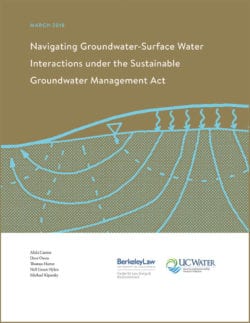 California’s Sustainable Groundwater Management Act (SGMA), passed in 2014, recognizes and addresses connections between surface water and groundwater. The statute is California’s first statewide law to explicitly reflect the fact that surface water and groundwater are frequently interconnected and that groundwater management can impact groundwater-dependent ecosystems, surface water flows, and the beneficial uses of those flows. As such, SGMA partially remedies the historically problematic practice of treating groundwater and surface water as legally distinct resources.
California’s Sustainable Groundwater Management Act (SGMA), passed in 2014, recognizes and addresses connections between surface water and groundwater. The statute is California’s first statewide law to explicitly reflect the fact that surface water and groundwater are frequently interconnected and that groundwater management can impact groundwater-dependent ecosystems, surface water flows, and the beneficial uses of those flows. As such, SGMA partially remedies the historically problematic practice of treating groundwater and surface water as legally distinct resources.
June 2017
Trading Sustainably: Critical Considerations for Local Groundwater Markets Under the Sustainable Groundwater Management Act
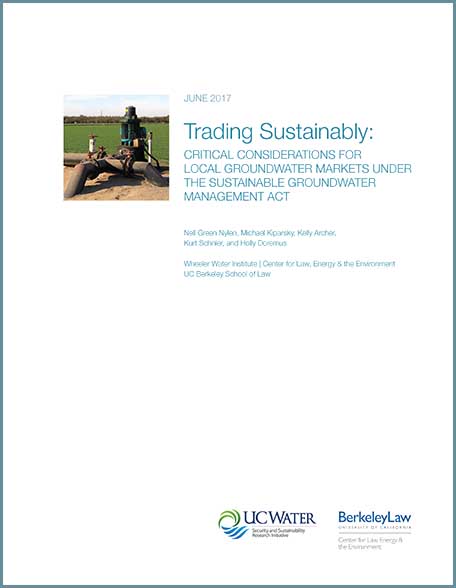 California’s Sustainable Groundwater Management Act (SGMA) potentially opens the door for local groundwater markets, however, it does not provide guidance about when a local groundwater market might be a useful and appropriate management tool. Our new report outlines a set of considerations designed to help decision makers and stakeholders evaluate whether a local groundwater market might be a viable tool for sustainably managing their groundwater basins and, if so, how to effectively implement it.
California’s Sustainable Groundwater Management Act (SGMA) potentially opens the door for local groundwater markets, however, it does not provide guidance about when a local groundwater market might be a useful and appropriate management tool. Our new report outlines a set of considerations designed to help decision makers and stakeholders evaluate whether a local groundwater market might be a viable tool for sustainably managing their groundwater basins and, if so, how to effectively implement it.
December 2016
Unanswered Questions for Implementation of the Sustainable Groundwater Management Act
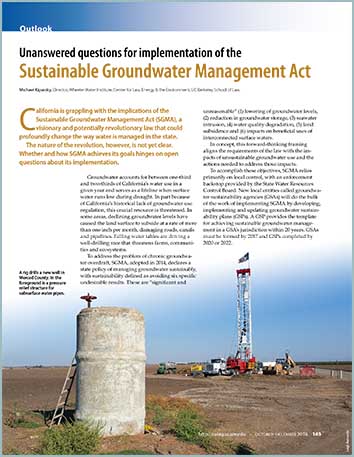 California is grappling with the implications of the Sustainable Groundwater Management Act (SGMA), a visionary and potentially revolutionary law that could profoundly change the way water is managed in the state. The nature of the revolution, however, is not yet clear. Whether and how SGMA achieves its goals hinges on open questions about its implementation. In this article we lay out a set of questions that must be answered before the policy goals given in SGMA can be translated into successful and sustainable groundwater governance.
California is grappling with the implications of the Sustainable Groundwater Management Act (SGMA), a visionary and potentially revolutionary law that could profoundly change the way water is managed in the state. The nature of the revolution, however, is not yet clear. Whether and how SGMA achieves its goals hinges on open questions about its implementation. In this article we lay out a set of questions that must be answered before the policy goals given in SGMA can be translated into successful and sustainable groundwater governance.
March 2016
Designing Effective Groundwater Sustainability Agencies: Criteria for Evaluation of Local Governance Options
A new law requires California governments to form dozens of new agencies to manage groundwater. However, the law does not give them specific direction on what they will need to do, or how they can set themselves up for success. To address the need for guidance, we developed a framework to help these agencies prepare to manage this critical resource for the first time.


